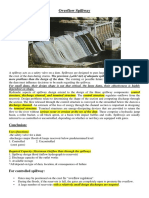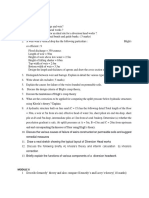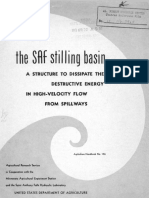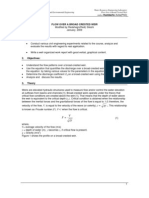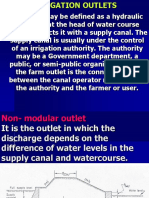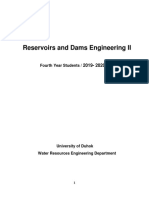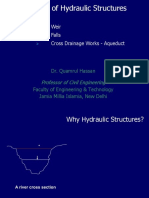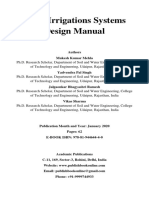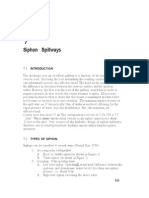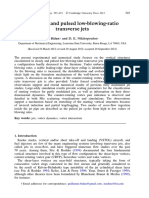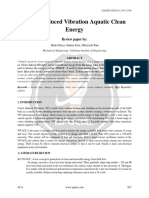Ch-5 Spillways-5
Ch-5 Spillways-5
Uploaded by
Fikir YoCopyright:
Available Formats
Ch-5 Spillways-5
Ch-5 Spillways-5
Uploaded by
Fikir YoCopyright
Available Formats
Share this document
Did you find this document useful?
Is this content inappropriate?
Copyright:
Available Formats
Ch-5 Spillways-5
Ch-5 Spillways-5
Uploaded by
Fikir YoCopyright:
Available Formats
HE/IE 732 DAM ENGINEERING III – APPURTENANT STRUCTURES
Shaft Spillways
Introduction
The shaft spillway is simply a closed conduit in which the flood flow is carried rapidly from a high
to a low elevation. It is similar to a siphon spillway except for the absence of siphon action.
Spillways of this general type are used not only for dams (where they are commonly known as
morning glory spillways or glory holes), but also for erosion-control structures and as highway
culverts (commonly known as drop-inlet spillways or drop-inlet culverts). This type of spillway can
be used advantageously at dam sites in narrow canyons where the abutments rise steeply or
where a diversion tunnel or conduit is available for use as the downstream leg. Another
advantage of this type of spillway is that near-maximum capacity is attained at relatively low
heads and this characteristic makes the spillway ideal for use where the maximum spillway
outflow is to be limited. For this reason, they are most suited where temporary storage space in
the reservoir is large enough to significantly attenuate the incoming flood.
Types of Shaft Spillways
Shaft spillways are classified according to hydraulic action.
I. Spillways with axial flow in the shaft as well as in the downstream leg or tunnel.
Different combinations of flow conditions are possible:
A. Free flow in the shaft as well as in the tunnel.
B. Free flow in the shaft and pressure flow in the tunnel.
C. Pressure flow in the shaft and free flow in the tunnel.
D. Pressure flow in both, the shaft as well as in the tunnel.
II. Spillways with vortex or swirling flow in the shaft and axial flow in the tunnel.
III. Spillways with axial flow in the shaft and swirling flow in the tunnel.
IV. Siphon-shaft spillways.
Shaft Spillways with Axial Flow
The principal elements of a shaft spillway are an intake including spillway crest, transition from
the crest to the shaft, the bend, and the downstream leg, and a tunnel and energy dissipator, as
shown in Figure 1.
Although, most of the shaft spillways have their intakes with a crest of circular plan form and
cylindrical shafts, rectangular plan forms are not uncommon. Shaft spillways with arrangement of
double shafts, to increase the discharge capacity, have also been constructed.
Elbow type shaft spillways, as shown in Figure 2, can be conveniently constructed, where
topography does not permit radial inflow conditions.
Figure 1 Elements of a shaft spillway.
AMU, SGS - Lecture Note -1-
HE/IE 732 DAM ENGINEERING III – APPURTENANT STRUCTURES
Figure 2 Shaft spillways of other shapes.
Hydraulic Action
Typical flow conditions and discharge characteristics for a shaft spillway with axial flow
are depicted in Figure 3.
Generally, a free weir flow prevails over the crest for Ho/Rs up to about 0.45, partly
submerged weir flow for Ho/Rs values between 0.45 and 1.0, and above this value the
weir is completely submerged and the coefficient of discharge sharply falls.
Since it is impractical to construct a conduit with varying diameter, it is generally made a
constant size beyond the inlet formation. Thus, the conduit from the control point to the
downstream end will have an excess area. If atmospheric pressure can be maintained
along the portion of the conduit flowing partly full, it will continue to flow at that stage up
to certain discharge.
As the discharge over the crest increases, the overflowing annular nappe becomes
thicker and converges into a solid vertical jet. The point where the annular nappe joins
the solid jet is called the crotch. After the solid jet forms, a boil occupies the region
AMU, SGS - Lecture Note -2-
HE/IE 732 DAM ENGINEERING III – APPURTENANT STRUCTURES
above the crotch and both the crotch and the top of the boil rise progressively higher
with an increase in the discharge. For high heads, the crotch and boil may almost fade
out as a slight depression on the surface.
Figure 3 Flow conditions and discharge characteristics (USBR)
AMU, SGS - Lecture Note -3-
HE/IE 732 DAM ENGINEERING III – APPURTENANT STRUCTURES
With the increase in the discharge, submergence of the crest begins and the control
section moves gradually from the vertical bend to the throat, reaching finally a
relationship Q= f(Ho1/2). The onset of this condition is unstable and often violent, marked
by severe pressure fluctuations.
For a still higher discharge, if the condition of pipe flow is reached, both the inlet and
outlet ends may be sealed and siphonic action may set in. The discharge function is then
given by Q=f(Ht - Hl). If air vents are not provided, or if aeration is inadequate, a make-
or-break siphon action will accompany the flow with a range of discharges approaching
full flow conditions. Erratic discharge vibrations and surges accompany this action. It is
therefore necessary to ensure at the design stage what the expected hydraulic action is
for the entire range of discharges and to provide for them. This becomes all the more
obligatory when the existing diversion tunnels are utilized as downstream legs of the
shaft spillway.
Analysis of Alternatives
As discussed earlier, shaft spillways with axial flow in the shaft, as well as in the tunnel,
have four possible alternatives: free flowing shaft with tunnel flowing free or pressurized,
and pressurized shaft with tunnel flowing free or pressurized. The decision whether the
tunnel should be free flow or pressurized is crucial.
Whether to design the tunnel as free flow or pressure flow should be based on the
influence of the parameters such as total head (H), tunnel slope (i), and its length (L).
For this analysis, H is greater than 13–15 m, slope i may be supercritical or sub-critical,
and length L is considered to be long when hydraulic jump stays out for the tunnel for
30% design discharge and above. Generally, straight and short tunnels, steep
slopes, existing large cross sections, and flat and low tail waters favor a free flow
tunnel; whereas long and curved tunnels, existing small cross-sections, and high
and sensitive tail waters lead to the selection of a pressure tunnel. Table 1
indicates preferences for various combinations of H, i, and L.
FREE SHAFT SPILLWAYS
Shaft spillways for flood disposal that have a relatively short length of the tunnel should
preferably be designed as free shaft spillways. Commonly the free flow condition in the
shaft spillway comprises two reaches: the shaft itself and the tunnel. For low flows, weir
control may exist and the shaft may run free, whereas for high flow the shaft may be
pressurized while the tunnel remains in free flow condition for the entire range of
discharges. Generally, the tunnel section is selected so that it will not flow more than 75
to 80% full at the downstream end for the maximum discharge. Under this condition, air
will access from the downstream portal and prevent sub-atmospheric pressure in the
tunnel. However, vertical or horizontal curvatures in the tunnel profile have to be
designed so that sealing along any portion is avoided.
The shaft spillways where both the shaft and tunnel run free flow involve the following
design considerations:
-Crest profile
-Transition from crest to shaft
-Discharge characteristics
-Air entrainment in shaft
-Air entrainment in tunnel flowing partly full
AMU, SGS - Lecture Note -4-
HE/IE 732 DAM ENGINEERING III – APPURTENANT STRUCTURES
Crest Profile
The crest profile of a morning glory intake conforms to the lower surface of a nappe
flowing over an aerated sharp crested circular weir for various combinations of P/Rs and
Hs/Rs as shown in Figure 4. Rs and Hs are with reference to the theoretical sharp crest.
The head over the spillway crest Ho is considered for calculating discharging capacity.
Ho is related to Hs, Rs, and P.
The converging flow over the crest is influenced by head Hs, radius Rs, and height of the
crest P, and is so complex that a generalized mathematical equation defining the complete
profile—as in the case of straight ogee spillway—has not been possible. USBR have
compiled data in tabular form, in respect of coordinates of crest profiles for values of P/Rs =
0.15, 0.30, and 2.0, and Hs/Rs of 0.2 to 2.0 based on a study by Wagner (1956). Use of these
tables requires relationship between Ho and Hs, as shown in Figure 4.
AMU, SGS - Lecture Note -5-
HE/IE 732 DAM ENGINEERING III – APPURTENANT STRUCTURES
Figure 4 Crest profile of a morning glory spillway intake: P =Height of the crest above the bed, Rs = Radius
of the crest circle, and Hs =Total head above the theoretical sharp crest.
In contrast to the crest profiles of straight spillways, where the profiles become flatter
with increasing heads, the crest profiles for circular weirs become steeper as the head
increases, as can be seen from Figure 5.
If the crest profile is designed for heads where Hs/Rs exceed 0.25–0.30, sub-atmospheric
pressures will occur on some portion of the profile for heads less than design head. If
AMU, SGS - Lecture Note -6-
HE/IE 732 DAM ENGINEERING III – APPURTENANT STRUCTURES
this is to be avoided, crest profile should be designed corresponding to an increased
radius R′s as per the graph given in Figure 6 and with H′s/R′s =0.3.
Figure 6 Increased crest radius needed to minimize sub atmospheric pressures. (USBR)
Values of coordinates that define the shape of the lower surface of a nappe flowing over
an aerated sharp-crested circular weir for various conditions of P/Rs and Hs/Rs are shown
in tables 2, 3, and 4. These data are based on experimental tests conducted by the US
Bureau of Reclamation. The relationships of Hs to Ho are shown on figure 8.
Transition from Crest to Shaft
The circular crest should converge to the shaft; the shaft’s diameter would generally be
the same as the diameter of the downstream leg or tunnel. USBR proposed a transition
on the basis of continuity equation, considering the flow as a free falling, circular jet
issuing from a horizontal orifice. Thus, Q = Area of the jet x Velocity of the jet, i.e.,
Q= πR 2 2gH a , where Ha is the difference between the water surface and the elevation
under consideration. Assuming losses to account for contraction, friction, etc. as 10% of
the head
-------------------------------------------------------------------------------------------(1)
A similar criterion has been proposed that the velocity head should be lower than the
total available energy at a given point, to prevent separation and instability and hence
-------------------------------------(2)
Which is nearly the same result as given by Equation 1.
The curve R = f(Ha) for the design discharge is plotted along with the crest profile and
the transition is adjusted for the shaft diameter.
AMU, SGS - Lecture Note -7-
HE/IE 732 DAM ENGINEERING III – APPURTENANT STRUCTURES
Discharge Characteristics
The discharge characteristics of the crest (Fig. 4) is defined by the circular crest
coefficient Co as
--------------------------------------------------------------------(3)
C0 depends on Ha/Rs and P/Rs. The experimental discharge coefficients for design head
on spillway crest H0 have been published by USBR on the basis of studies by Wagner
(1956). These curves transformed in SI units are shown in Figure 7(a). It will be seen
that C0 increases with reduction of approach depth P, in contrast to straight spillways.
Coefficient of discharge for heads other than the design head can be determined from
Figure 7(b), for preparing the discharge-rating curve. However, this relationship is valid for
the crest profiles free of sub-atmospheric pressures, i.e., for profiles designed based on
radius according to Figure 6 and for Hs /Rs= 0.3. It is also not applicable for He / Rs > 0.4.
Figure 7 Discharge characteristics based on studies by Wagner (1956): Curves shown – – are extrapolated (USBR).
AMU, SGS - Lecture Note -8-
HE/IE 732 DAM ENGINEERING III – APPURTENANT STRUCTURES
Figure 8 Relationship of Hs/H0 to HO/Rs for circular sharp-crested weirs (USBR).
Illustrative Examples
1. Design a shaft spillway to pass a design discharge of 410 m3/s, without exceeding the
depth of overflow of 2.35 m. Assume P/Rs=0.3.
Solution
The design involves a trial method. The calculations begin with an assumed value of radius of the
crest circle and finding the discharge corresponding to Ho=2.35 m.
Starting with an assumed value of Rs=5m, Ho/Rs=0.47 gives a coefficient of discharge of 1.96,
corresponding to P/Rs=0.30.
Q = C0 (2πRs )H 0 2 =222,
3
which is much less. With Rs=10 m, Ho/Rs = 0.235, Co=2.16 and
3
Q=489 m /s, indicating a larger than required radius.
Finally, Rs= 8.5 m gives Ho/Rs=0.276,Co=2.15 and Q = 414 m3/s, which is acceptable.
For working out the coordinates of crest profile, the value of Hs/Rs is required. For Ho/Rs=0.276
and P/Rs=0.3, Hs/Ho=1.085 (Figure 8). Thus, Hs=2.55 m and Hs/Rs=0.30. Accordingly, the crest
profile worked out is shown in Figure E1. The coordinates corresponding to Hs/Rs=0.20 are also
plotted therein for comparison.
AMU, SGS - Lecture Note -9-
HE/IE 732 DAM ENGINEERING III – APPURTENANT STRUCTURES
Figure E1 Illustrative example.
The profile of the transition is given by Equation 1:
A shaft diameter of 3m is indicated as shown in Figure E1.
AMU, SGS - Lecture Note -10-
HE/IE 732 DAM ENGINEERING III – APPURTENANT STRUCTURES
Table 2. Coordinates of lower nappe surface for different values of Hs/Rs when P/Rs= 2.0.
AMU, SGS - Lecture Note -11-
HE/IE 732 DAM ENGINEERING III – APPURTENANT STRUCTURES
Table 3. Coordinates of lower nappe surface for different values of Hs/Rs when P/Rs= 0.30.
AMU, SGS - Lecture Note -12-
HE/IE 732 DAM ENGINEERING III – APPURTENANT STRUCTURES
Table 4. Coordinates of lower nappe surface for different values of Hs/Rs when P/Rs= 0.15.
AMU, SGS - Lecture Note -13-
HE/IE 732 DAM ENGINEERING III – APPURTENANT STRUCTURES
Air Entrainment in Drop Shafts
Air entrainment and air release in the axial flow shaft spillways and drop shafts are the
most important, yet complicated, design problems. Air entrainment in drop shafts occurs
when the flow strikes the water column in the lower portion of the shaft, regardless of the
type of intake whether radial, elbow, or vortex.
The air entrainment mechanism is closely related to the type of flow conditions in the
shaft and has been schematically illustrated in Figure 9. At the beginning of overflow
with low water levels, the discharge characteristics are similar to a weir control and the
flow in the shaft clings to the walls as a relatively thin sheet. The volume flow rate of air
is determined by the shear action of the air-water interface and by entrainment into the
mass of water. This type of flow has been designated as Region I. The quantity of air
entrained increases with discharge and with the increase in discharge, a point is reached
when the sheet of water is sufficiently thick to completely seal the air passage at the
lower end of the shaft.
Figure 9 Flow condition in the shaft
This water discharge separates Region I from Region II. This type of flow is
characterized by an annular hydraulic jump. Further increase in the discharge merely
causes the location of the jump to move upward in the vertical shaft. The quantity of air
entrained then decreases with discharge. When the jump reaches a point near the top of
the shaft, the flow is said to become submerged. For reservoir elevations in excess of
that required to produce the submerged water flow, inflow of air to the shaft ceases, if no
air-entraining vortices occur. This is Region III where the discharge is similar to a pipe
flow.
AMU, SGS - Lecture Note -14-
HE/IE 732 DAM ENGINEERING III – APPURTENANT STRUCTURES
The air flow rate for region I is calculated assuming that the water flow on the shaft walls
is similar to open channel flow, and the lower end of the shaft is accessible to
atmosphere. The relationships are derived based on the study on a model of a drop
shaft which ensured simulation of appropriate flow conditions of Region I.
------------------------------------------------------------------(4)
-------------------------------------------------------------------------(5)
-----------------------------------------------(6)
-------------------------------------------------------(7)
Flow characteristics of region II are similar to that of a ring jump and the application of
the following relationship is suggested.
------------------------------------------------(8)
In region III, the shaft is under submergence and the airflow down the shaft ceases.
According to USBR (1973), this condition corresponds to H0 / Rs ≥ 1. No air
entrainment will take place if an air-entraining vortex does not form. With the fully
submerged condition, no air-entraining vortex will form so far as the approach flow is
radial. However, for an approach flow having some circulation, a vortex may form with
undesirable effects such as air entrainment, vibration, loss of performance, etc. A
number of investigators have suggested the required submergence for ensuring
absence of air entraining vortices. There is considerable variation in their results. The
S/d values range from 0.20 to 4.0 for F varying from 0.1 to 0.8. The results are believed
to be influenced by the approach configurations and scale effects.
A relationship applicable only for radial flow is given below,
AMU, SGS - Lecture Note -15-
HE/IE 732 DAM ENGINEERING III – APPURTENANT STRUCTURES
------------------------------------------------------------------(9)
Experiments with other models yield a similar relationship
-----------------------------------------------------------(10)
A reasonably conservative estimate of the submergence can be given by
--------------------------------------------------------------(11)
In order to ensure radial flow, at least in the vicinity of the crest, guide piers and vanes
on the crest profile are usually provided, as shown in Figure 10.
Figure 10 Guide piers to ensure radial flow
PRESSURE SHAFT SPILLWAYS
Designing shaft spillways, or drop shafts with long tunnels, or tunnels on curved
alignment for free surface flow may be difficult and prove to be uneconomical. In such
cases, alternatives of pressurized tunnel may prove to be advantageous.
In a pressure shaft spillway, the tunnel is permanently flowing full, the shaft itself may be
or not pressurized. The advantages of such a condition are:
- The flow conditions are less dependent on the tail water-rating curve, which is
not the case with the free shaft spillway.
- The flow conditions are more tranquil and average velocities are significantly
lower than those for the free flow tunnel. For the free tunnel these may be as
high as 35 to 40 m/s, in the pressure tunnel, the practical limit is in the range of
16 to 18 m/s and yet require smaller tunnel cross section for the same discharge.
AMU, SGS - Lecture Note -16-
HE/IE 732 DAM ENGINEERING III – APPURTENANT STRUCTURES
Some of the disadvantages are:
- The main problem is to tackle air entrainment, or rather de-aeration, to avoid
difficulties described in Section 8.3.1 earlier.
- Tunnel cross-section has to be fully concrete lined and designed for pressure
flow.
- Energy dissipators tend to be more expensive.
Devices to Ensure Pressurized Flow in the Shaft
If the shaft is not flowing full, hydro-pneumatic phenomena may occur and disturb the
flow at the tunnel. Special devices are suggested at various locations that force the
formation of a stationary water column in the shaft, with the minimum height required, to
significantly reduce the air discharges and mass oscillation. Some of these are:
These are shown in Figure 11. It must, however, be noted that such devices cause
additional head loss which may require further enlargement of cross-sections of shafts
and tunnels to meet the design capacities. The optimum solution for a specific case must
be obtained through hydraulic model studies.
Figure 11 Devices to ensure pressurized flow in the shaft: (1) Special shape of the bell mouth
entry, (2) Chute blocks on the shaft mouth, (3) Siphon at the base, (4) short radius bend, (5) T-
transition, (6) Nozzle, and (7) Stilling basin with diving flow.
AMU, SGS - Lecture Note -17-
You might also like
- Relativity VisualizedDocument239 pagesRelativity Visualizedkaplanis8594% (17)
- 1877 PDFDocument8 pages1877 PDFAhmed AlbayatiNo ratings yet
- Fluid MechanicsDocument22 pagesFluid MechanicsAdeola OdeleyeNo ratings yet
- Rotating VesselsDocument83 pagesRotating VesselsSonic HedgehogNo ratings yet
- Spillways: 5.1. 5.2. General Formula 5.3. Sharp-Crested Weir 5.4. The Overflow Spillway 5.5. Broad-Crested WeirDocument17 pagesSpillways: 5.1. 5.2. General Formula 5.3. Sharp-Crested Weir 5.4. The Overflow Spillway 5.5. Broad-Crested WeirAlejandro GonzalezNo ratings yet
- The Broad Crested WeirDocument6 pagesThe Broad Crested WeirIshara CoorayNo ratings yet
- G2.11 Reservoir PlanningDocument16 pagesG2.11 Reservoir PlanningJenny Moreno100% (2)
- Chapter 2 SpillwayDocument83 pagesChapter 2 SpillwayKaseye AmareNo ratings yet
- CH 1 Introduction WS&TDocument82 pagesCH 1 Introduction WS&Ttemesgen yohannes100% (1)
- GW 4-Well Hydraulics-3Document19 pagesGW 4-Well Hydraulics-3wajid malikNo ratings yet
- Ce302 - Dhs Question BankDocument5 pagesCe302 - Dhs Question Banksyamak0% (1)
- Saint Anthony Falls (SAF Stilling Basin)Document16 pagesSaint Anthony Falls (SAF Stilling Basin)Henry Alvarez100% (1)
- Arch DamDocument15 pagesArch DamHenok MandefroNo ratings yet
- About Chute SpillwayDocument15 pagesAbout Chute SpillwayPrem Singh RawatNo ratings yet
- Hydraulic-Design-Of-Spillways PDFDocument46 pagesHydraulic-Design-Of-Spillways PDFkedagaal100% (1)
- Design of Channel Transitions: Victor M. PonceDocument20 pagesDesign of Channel Transitions: Victor M. PonceKostas LazarakisNo ratings yet
- Side Channel SpillwayDocument14 pagesSide Channel SpillwayNur Kholis Aji Pangestu IINo ratings yet
- 02 - 1 Design of Weir - Subsurface AnalysisDocument93 pages02 - 1 Design of Weir - Subsurface AnalysisMohammed JemalNo ratings yet
- Diversion WorksDocument16 pagesDiversion Worksmoha_yenus5333100% (2)
- Assignments-Design of Dam Appurtenant Structures-2022Document2 pagesAssignments-Design of Dam Appurtenant Structures-2022Marew Getie100% (2)
- Design Criteria of Stilling BasinDocument22 pagesDesign Criteria of Stilling Basinjagmeet singhNo ratings yet
- Chapter Five SpillwaysDocument85 pagesChapter Five Spillwayssubxaanalah0% (1)
- Module-III Concrete (Gravity) Dam EngineeringDocument43 pagesModule-III Concrete (Gravity) Dam EngineeringMadan Mohan ReddyNo ratings yet
- Final Year ProposalDocument6 pagesFinal Year ProposalAbdulbasit Aba BiyaNo ratings yet
- 3 - Design of Vertical Drop WeirDocument25 pages3 - Design of Vertical Drop WeirKesav kNo ratings yet
- Broad Crested Weir Module-3Document4 pagesBroad Crested Weir Module-3Arvin Bhurtun100% (1)
- Weir & Barrage Questions and AnswersDocument8 pagesWeir & Barrage Questions and AnswersAliyyi JamaalNo ratings yet
- OutletsDocument107 pagesOutletsHassan 62No ratings yet
- LANE, BLIGH & Khosla TheoriesDocument1 pageLANE, BLIGH & Khosla TheoriesLo0oVve50% (8)
- Chapter 8Document16 pagesChapter 8Mohit Kumar RaiNo ratings yet
- OutletsDocument107 pagesOutletsNumair Ahmad FarjanNo ratings yet
- CH 5 Cross DrinageDocument40 pagesCH 5 Cross DrinageAbuye HDNo ratings yet
- Assignment On Concrete Dam Design and AnalysisDocument1 pageAssignment On Concrete Dam Design and AnalysisHabtamu Hailu100% (1)
- Hydraulic Structures-I Tutorial ClassDocument25 pagesHydraulic Structures-I Tutorial ClassChuol Jock Deng100% (1)
- Side Channel Design ReportDocument32 pagesSide Channel Design ReportMariyan TraykovNo ratings yet
- WeirsDocument6 pagesWeirsJessicalba LouNo ratings yet
- MCQ Ahe U6Document3 pagesMCQ Ahe U6Abhijeeth Nagaraj100% (2)
- Lecture 01b - Reservoirs (Part 2)Document59 pagesLecture 01b - Reservoirs (Part 2)Cj GumiranNo ratings yet
- Chapter One Arch Dam 2020Document14 pagesChapter One Arch Dam 2020Ali ahmedNo ratings yet
- Design of Concrete Gravity Dam SectionsDocument23 pagesDesign of Concrete Gravity Dam SectionsManan ParikhNo ratings yet
- Transition For Small CanalsDocument50 pagesTransition For Small CanalsZac MwebNo ratings yet
- Hydraulic Structures II (Design of Diversion and Canal Structures)Document38 pagesHydraulic Structures II (Design of Diversion and Canal Structures)zelalemniguseNo ratings yet
- Chapter Four 4. Irrigation Canals and DesignDocument8 pagesChapter Four 4. Irrigation Canals and DesignBrooke AbebeNo ratings yet
- Spill WaysDocument14 pagesSpill WayshailishNo ratings yet
- CEng 6803 Course Work IDocument2 pagesCEng 6803 Course Work Iyared sitotaw100% (1)
- Concret DamDocument30 pagesConcret DamYosi100% (1)
- 10CV65 - Hydraulic Structures and Irrigation Design - Drawing Question BankDocument6 pages10CV65 - Hydraulic Structures and Irrigation Design - Drawing Question BankMr. Y. RajeshNo ratings yet
- Cvs 348: Engineering HydrologyDocument11 pagesCvs 348: Engineering Hydrologysalt2009No ratings yet
- Lining CanalDocument39 pagesLining CanalAastha SoniNo ratings yet
- Open Channel Lectures Ahmed SaadiDocument40 pagesOpen Channel Lectures Ahmed SaadiحسامNo ratings yet
- Fet Ci Lecture Notes Prof Quamrul Hassan Design-WeirDocument53 pagesFet Ci Lecture Notes Prof Quamrul Hassan Design-WeirVEDANT SHARMA 129No ratings yet
- Chapter 5 Diversion Head WorksDocument58 pagesChapter 5 Diversion Head Worksbpiuyt123No ratings yet
- Gravity Dam DesignDocument48 pagesGravity Dam DesignGhimire AnubhavNo ratings yet
- Design of Bucket Type Energy Dissipator PDFDocument35 pagesDesign of Bucket Type Energy Dissipator PDFMilind Gupta100% (1)
- Farm Irrigations Systems Design ManualDocument72 pagesFarm Irrigations Systems Design ManualAshenafi GobezayehuNo ratings yet
- CENG 6606 HSII - 2 Diversion Head WorksDocument29 pagesCENG 6606 HSII - 2 Diversion Head WorksKenenisa BultiNo ratings yet
- How To Calculate The Specific Capacity of A Well - Ground WaterDocument13 pagesHow To Calculate The Specific Capacity of A Well - Ground WaterSATVINDAR SINGHNo ratings yet
- Ecohydrology: Vegetation Function, Water and Resource ManagementFrom EverandEcohydrology: Vegetation Function, Water and Resource ManagementNo ratings yet
- Chapter 4 FLOW MEASUREMENTDocument53 pagesChapter 4 FLOW MEASUREMENTCostinel CristescuNo ratings yet
- CH 4 Spillways 4Document11 pagesCH 4 Spillways 4Fikir YoNo ratings yet
- Chapter 6-SpillwaysDocument27 pagesChapter 6-SpillwaysMohamed Al-Odat100% (1)
- Chapter 3Document55 pagesChapter 3megersatolasaNo ratings yet
- Vertedores en SifónDocument21 pagesVertedores en SifónEfrenNo ratings yet
- CH 4 Spillways 4Document11 pagesCH 4 Spillways 4Fikir YoNo ratings yet
- Ch-6 Spillways-6Document5 pagesCh-6 Spillways-6Fikir YoNo ratings yet
- Ch-1 Spillways-1Document6 pagesCh-1 Spillways-1Fikir YoNo ratings yet
- New Dam Plan Review Checklist: General Design InformationDocument2 pagesNew Dam Plan Review Checklist: General Design InformationFikir YoNo ratings yet
- Design and Evaluation of A Dean Vortex-Based MicromixerDocument7 pagesDesign and Evaluation of A Dean Vortex-Based MicromixerEr Mayur PatilNo ratings yet
- Airbus Fast Magazine 51Document41 pagesAirbus Fast Magazine 51Rama Renspandy100% (1)
- Design of Tall VesselsDocument54 pagesDesign of Tall VesselsboiroyNo ratings yet
- On Steady and Pulsed Low-Blowing-Ratio Transverse JetsDocument41 pagesOn Steady and Pulsed Low-Blowing-Ratio Transverse Jetssamik4uNo ratings yet
- Tornadogenesis Presentation - Markowski - InGDocument29 pagesTornadogenesis Presentation - Markowski - InGDellmannsNo ratings yet
- Lab 4 - Agitation and Mixing of Liquids (Group W2)Document16 pagesLab 4 - Agitation and Mixing of Liquids (Group W2)Cambo SUTNo ratings yet
- Bridge Aerodynamic Stability PDFDocument114 pagesBridge Aerodynamic Stability PDF75bm73No ratings yet
- External and Internal Cooling Techniques in A Gas Turbine Blade An Overview IJERTV10IS080055Document11 pagesExternal and Internal Cooling Techniques in A Gas Turbine Blade An Overview IJERTV10IS080055Badr BouananeNo ratings yet
- PES TR17 Aeolian Vibration of Single Conductors Final 08 17 2015 PDFDocument38 pagesPES TR17 Aeolian Vibration of Single Conductors Final 08 17 2015 PDFFirstface LastbookNo ratings yet
- Wind Noise Sources and ReductionDocument10 pagesWind Noise Sources and ReductionAchintya MehrotraNo ratings yet
- Flow Physics of A Race Car Wing With Vortex Generators in Ground EffectDocument9 pagesFlow Physics of A Race Car Wing With Vortex Generators in Ground EffectVyssion100% (1)
- Mission Centrifugal Pumps CatalogDocument60 pagesMission Centrifugal Pumps CatalogSebastian Plata100% (2)
- Mixing PartDocument47 pagesMixing Partحمزة الفنينيNo ratings yet
- 2 Flow MeasurementDocument20 pages2 Flow MeasurementTú MinhNo ratings yet
- VortexDocument8 pagesVortexZzPumpkingNo ratings yet
- Vortex Cooler: Description: Compact, Reliable and Low Cost Way To Cool and PurgeDocument4 pagesVortex Cooler: Description: Compact, Reliable and Low Cost Way To Cool and PurgeDave MartinNo ratings yet
- Aerodynamics - What Is Vortex LiftDocument6 pagesAerodynamics - What Is Vortex LiftSepideNo ratings yet
- Ship Resistance NotesDocument66 pagesShip Resistance Noteskhalaf1987No ratings yet
- Vortex Induced Vibration Aquatic Clean Energy Ijariie4114Document5 pagesVortex Induced Vibration Aquatic Clean Energy Ijariie4114Reham El- DawyNo ratings yet
- Heat Exchanger VibrationDocument3 pagesHeat Exchanger VibrationTim KuNo ratings yet
- RANQUE-HILSCH VORTEX TUBE-To StudentsDocument12 pagesRANQUE-HILSCH VORTEX TUBE-To StudentsMohamed MoatazNo ratings yet
- Heat Bearings and Lubrication Engineering Analysis of Thermally Coupled Shear Flows and Elastic Solid Boundaries PDFDocument225 pagesHeat Bearings and Lubrication Engineering Analysis of Thermally Coupled Shear Flows and Elastic Solid Boundaries PDFJairoQuirozGomezNo ratings yet
- Physica C: Superconductivity and Its Applications: J.A. Galvis, E. Herrera, I. Guillamón, S. Vieira, H. SuderowDocument7 pagesPhysica C: Superconductivity and Its Applications: J.A. Galvis, E. Herrera, I. Guillamón, S. Vieira, H. Suderowparsa hooshyarNo ratings yet
- 02whole PDFDocument213 pages02whole PDFGopi Chand ReddyNo ratings yet
- Vortex Bladeless WindmillDocument13 pagesVortex Bladeless Windmillnachi stinnuNo ratings yet
- 3.CFDLV11 N2 P32 41Document11 pages3.CFDLV11 N2 P32 41For YoutubeNo ratings yet
- Basic Aerodynamics Module 4Document86 pagesBasic Aerodynamics Module 4Asyraf Samad100% (1)

